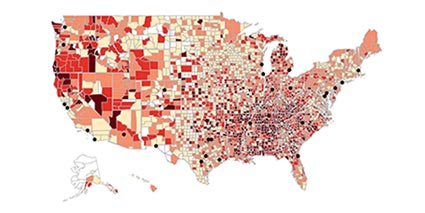National Deluge of Opiates, Causes and Costs
In May, 2017 the United States Drug Enforcement Agency announced that Albuquerque would become the seventh city in the nation to participate in its 360 Strategy Program which began in 2015 as an effort to meld community outreach and law enforcement efforts to fight against drug cartels and trafficking activities. Among other activities, the community outreach efforts target drug manufacturers and pharmacists to raise awareness of the opiate epidemic that has swept the nation over the course of the past decade. An article in US News & World Report covers the launch of the effort and notes that New Mexico experiences one of the highest opiate overdose rates in the nation. In recognition of the problem, the State became the first in the nation to require all local and state law enforcement agencies to carry anti-overdose kits such as Naloxone.
Flood of Prescription Opiates
The explosion in the use of opiates in the United States can clearly be seen in the data reported by the Centers for Disease Control (CDC) during the period 2006-2016. In 2006, a total of 215,917,663 Opiate prescriptions were issued in the United States. This represents 72.4 prescriptions per 100 residents in the country, an astonishing rate of use. The year 2012 marked the apex of the opioid prescription frenzy: That year, 255,207,954 opiate prescriptions were authorized or 81.3 per 100 residents. An astounding increase of more than 40 million drug prescriptions!
This colossal deluge of prescription potent pain-killers has had dire and often lethal consequences in every community and every state in the nation. In response to vigorous criticism from a variety of social sectors, rates of prescribing have tapered off since 2012 yet the damage has been done. Cutting people off from legal channels often translates into spikes in consumption of illegal opioids such as Heroin. No rational source contests the existence of a major problem with opiates in the United States and multiple sources are now targeting a specific set of culprits responsible for the epidemic and its horrendous consequences.
Big Pharma Posts Huge Profits as Tens of Thousands Die
A Newsweek article, which appeared in August, 2017 and entitled, “Has Big Pharma Made America a Country of Opioid Drug Addicts?”, it is pointed out that big pharmaceutical companies engaged in a deliberate campaign aimed at proliferating use and dependency among large numbers of Americans. In West Virginia, Big Pharma dumped enough pills over one six year period to suffice for 235 pills for every man, woman and child in the State. During the same period, over 1,700 people died from opiate overdoses.
Large pharmaceutical companies, according to multiple sources, orchestrated a national campaign aiming at nothing less than the enslavement to addiction and dependency of millions of Americans with one driving set of concerns and one alone, profit margins and marketability. So what if tens of thousands of people died. So what if millions of people were condemned to the woes of addiction and all that comes with it. What really mattered, to them, was market-share and share-holder returns. The CEOs of a handful of companies responsible boast among the highest compensation packages world-wide.
New Mexico Joins the Chorus of Criticism and Fights Back
On September 7, 2017 New Mexico’s Attorney General filed suit against eight large pharmaceutical companies joining what has become a chorus of lawsuits filed my multiple states and municipalities seeking redress for the horrendous consequences of Big Pharma’s fixation with profits over people. While a handful of drug-purveying fat cats made out very well, States and Municipalities have been left to clean up—and pay for—the mess for which Big Pharma is responsible.
The complaint filed by Attorney General Hector Balderas sets forth the specifics of the devastation caused and the consequences communities across the State have experienced. The complaint opens,
“Since 2008, New Mexico has had one of the highest rates of drug overdose death in the United States. Between 2008-2012, almost every county in New Mexico had a higher drug overdose death rate than the rate for the entire United States. In Rio Arriba County and Mora County, overdose death rates were more than five times the national rate:”
The complaint then proceeds to affix the lion’s share of the blame to the deliberate campaign conducted by multiple pharmaceutical companies whose only concern was profiteering, noting, “These pharmaceutical companies aggressively advertised to and persuaded doctors to prescribe highly addictive, dangerous opioids, turned patients into drug addicts for their own corporate profit”. The gargantuan profits netted by the handful of drug manufacturers stretched in to the billions of dollars.
Joining the State’s Attorney General and also filing suit are multiple Counties and Municipalities in New Mexico, including Mora and Bernalillo Counties.
Specifics of the Cost to New Mexicans
Nationally, 40 people die every day from overdoses involving opiates. In 2014, the total number of such deaths exceeded 19,000—that is almost triple the number of US-combat deaths in Iraq and Afghanistan during the sixteen years of the Global War on Terror! There are now millions of Americans who struggle with an addiction to opiates and the consequences compound across every County and every City in the country.
In New Mexico may be found one of the highest overdose rates in the nation. Deaths from legally obtained, prescription opiates exceeded the overdose deaths from illicitly obtained drugs in 2014 by 60%. According to the most recent data obtained from New Mexico’s Prescription Monitoring Program, 175,800 people in the State now have an opiate prescription. Rates of admission for treatment of an addictive disorder involving these drugs have sky-rocketed as have state expenditures. Attorney General Balderas’s complaint notes,
“The New Mexico Department of Health estimates that in 2007 alone prescription opioid abuse, and misuse cost New Mexico $890 million, taking into account costs such as excess medical and prescription costs, lost earnings from premature deaths, and the costs of correctional facility and police services.”
While big pharmaceutical companies and their CEOs went golfing and enjoyed unheard of profits, millions suffered and we all pay the cost. Think of it, in one year alone, the taxpayers of New Mexico paid almost one billion dollars in costs.
Ex-DEA agent: Opioid crisis fueled by drug industry and Congress – CBS News
Ex-DEA agent: Opioid crisis fueled by drug industry and Congress – CBS News In the midst of the worst drug epidemic in American history, the U.S. Drug Enforcement Administration’s ability to keep addictive opioids off U.S. streets was derailed — that according to Joe Rannazzisi, one of the most important whistleblowers ever interviewed by 60 Minutes. Rannazzisi ran the DEA’s Office of Diversion Control, the division that regulates and investigates the pharmaceutical industry. Now in a joint investigation by 60 Minutes and The Washington Post, Rannazzisi tells the inside story of how, he says, the opioid crisis was allowed to spread — aided by Congress, lobbyists, and a drug distribution industry that shipped, almost unchecked, hundreds of millions of pills to rogue pharmacies and pain clinics providing the rocket fuel for a crisis that, over the last two decades, has claimed 200,000 lives.
Opioid Crisis Fast Facts – CNN
Opioid Overdose | Drug Overdose | CDC Injury Center
Opioid Overdose | Drug Overdose | CDC Injury Center
The United States is in the midst of an opioid overdose epidemic.Opioids (including prescription opioids, heroin, and fentanyl) killed more than 33,000 people in 2015, more than any year on record. Nearly half of all opioid overdose deaths involve a prescription opioid.





